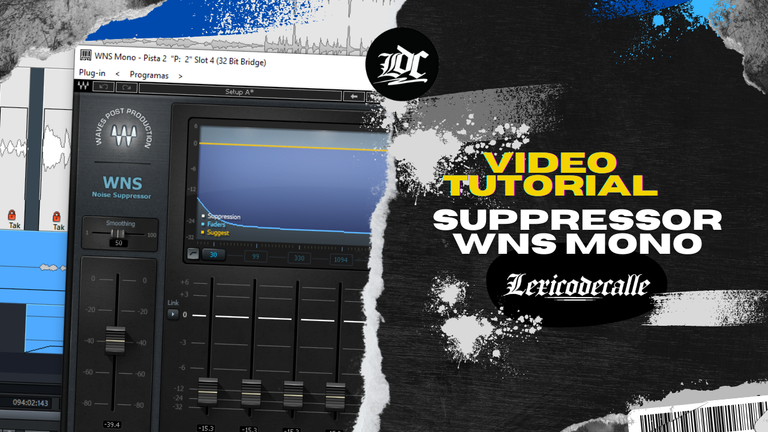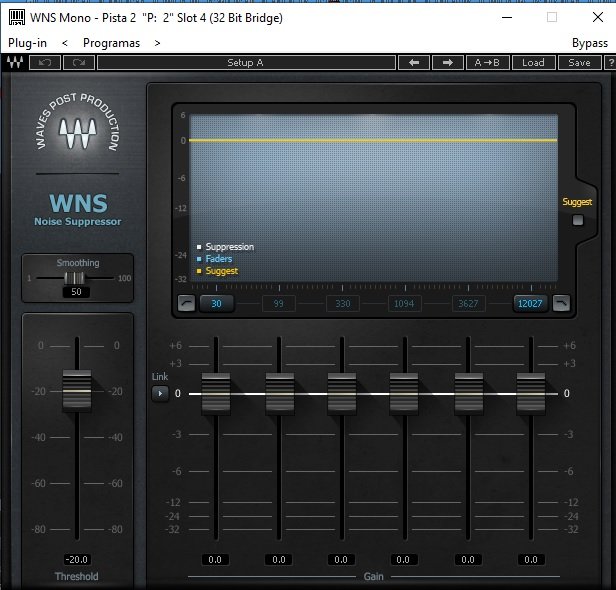
Resumen del Video Tutorial: Uso del Plugin WNS MONO en Samplitude para la Edición y Limpieza de Voces
En el mundo de la producción musical, la calidad del audio es crucial para lograr un resultado profesional y pulido. El video tutorial que vamos a resumir se enfoca en el uso del plugin WNS MONO para la edición y limpieza de voces en el software de edición de audio Samplitude. Este plugin es una herramienta potente para el procesamiento de audio, diseñada específicamente para reducir el ruido y mejorar la claridad de las grabaciones vocales. A continuación, desglosamos los aspectos clave del tutorial y cómo aplicar las técnicas presentadas para obtener los mejores resultados en tus proyectos musicales.
El tutorial comienza con una introducción al WNS MONO, un plugin especializado en la reducción de ruido y procesamiento de señales en mono. La primera parte del video detalla la interfaz del plugin, destacando los controles principales y cómo estos afectan el procesamiento de audio. El WNS MONO está diseñado para tratar grabaciones vocales, eliminando ruidos no deseados y mejorando la calidad general de la voz grabada.
Configuración Inicial en Samplitude
La siguiente sección del tutorial explica cómo configurar el WNS MONO en Samplitude. El video muestra el proceso paso a paso para cargar el plugin en una pista de voz. El primer paso es abrir Samplitude y cargar el proyecto en el que deseas trabajar. Luego, se debe insertar el WNS MONO en el canal de la pista vocal que se desea procesar. El tutorial muestra cómo acceder a la sección de plugins en la consola de mezcla y seleccionar el WNS MONO desde la lista de efectos disponibles.
Análisis del Audio y Ajuste de Parámetros
Una vez que el plugin está cargado, el siguiente paso es ajustar los parámetros del WNS MONO para adaptarlo a las características específicas de la grabación vocal. El tutorial profundiza en los controles principales del plugin:
Threshold (Umbral): Este control determina el nivel a partir del cual el plugin comenzará a aplicar la reducción de ruido. Ajustar el umbral correctamente es crucial para evitar que el audio se vuelva artificial o para mantener el equilibrio entre la reducción de ruido y la preservación de la calidad vocal.
Reduction (Reducción): Este parámetro controla la cantidad de reducción de ruido aplicada al audio. El video muestra cómo ajustar este control para obtener una limpieza efectiva sin afectar la calidad de la voz.
Frequency (Frecuencia): El WNS MONO permite ajustar el rango de frecuencias que se procesará. El tutorial recomienda seleccionar las frecuencias específicas que contienen el ruido no deseado, para que el plugin pueda eliminarlo sin afectar el rango vocal principal.
Attack and Release (Ataque y Liberación): Estos controles permiten ajustar la respuesta del plugin a los cambios en el audio. Un ataque rápido puede ser útil para eliminar ruidos transitorios, mientras que una liberación adecuada asegura que la reducción de ruido no sea abrupta.
Procesamiento en Tiempo Real y Comparación
El video tutorial enfatiza la importancia de escuchar el procesamiento en tiempo real. El presentador muestra cómo activar y desactivar el WNS MONO para comparar la versión procesada con la original. Esta comparación es esencial para asegurarse de que la reducción de ruido no está eliminando detalles importantes de la voz. El tutorial también sugiere usar herramientas de análisis visual, como medidores de espectro, para evaluar la efectividad de la reducción de ruido.
Aplicación de Ajustes Finos y Refinamiento
Después de ajustar los parámetros principales, el tutorial guía al espectador en la aplicación de ajustes finos para lograr un equilibrio perfecto entre la reducción de ruido y la calidad vocal. El presentador demuestra cómo realizar pequeñas modificaciones en los controles para mejorar la claridad sin introducir artefactos audibles. También se discuten técnicas avanzadas, como la automatización de parámetros, para adaptar el procesamiento a diferentes secciones de la grabación.
Consejos y Trucos Adicionales
En la sección final del tutorial, se ofrecen varios consejos y trucos adicionales para optimizar el uso del WNS MONO. Estos incluyen:
Uso de Presets: El video sugiere experimentar con los presets predefinidos del plugin como punto de partida. Los presets pueden ofrecer configuraciones útiles que se pueden ajustar según las necesidades específicas del proyecto.
Comparación A/B: Se recomienda realizar comparaciones A/B entre la versión procesada y la original para evaluar el impacto del plugin en el audio. Esta técnica ayuda a identificar cualquier problema y a realizar ajustes necesarios.
Mantenimiento de la Calidad Vocal: El tutorial advierte sobre la posibilidad de perder detalle vocal durante el procesamiento. Se sugiere prestar especial atención a la naturalidad de la voz y ajustar los parámetros para mantener la calidad original.
El video tutorial sobre el uso del plugin WNS MONO en Samplitude ofrece una guía completa para la edición y limpieza de voces. Desde la configuración inicial hasta los ajustes finos y consejos adicionales, el tutorial proporciona una visión detallada de cómo aprovechar al máximo esta herramienta para mejorar la calidad de tus grabaciones vocales. Siguiendo los pasos y técnicas presentados, puedes lograr una reducción de ruido efectiva y mantener la claridad y detalle de la voz, resultando en un sonido profesional y pulido.
El WNS MONO es una herramienta valiosa para cualquier productor musical que busque mejorar la calidad de sus grabaciones vocales, y el tutorial ofrece una guía práctica para utilizarlo de manera efectiva en tus proyectos.
Video Tutorial Summary: Using the WNS MONO Plugin in Samplitude for editing and cleaning vocals In the world of music production, audio quality is crucial for a professional and polished result. The video tutorial we are about to summarize focuses on the use of the WNS MONO plugin for editing and cleaning vocals in the audio editing software Samplitude. This plugin is a powerful audio processing tool specifically designed to reduce noise and improve the clarity of vocal recordings. Below, we break down the key aspects of the tutorial and how to apply the techniques presented to get the best results in your music projects. The tutorial begins with an introduction to WNS MONO, a plugin that specializes in noise reduction and mono signal processing. The first part of the video details the plugin's interface, highlighting the main controls and how they affect audio processing. WNS MONO is designed to treat vocal recordings, removing unwanted noise and improving the overall quality of the recorded voice. Initial configuration in Samplitude The next section of the tutorial explains how to configure WNS MONO in Samplitude. The video shows the step-by-step process for loading the plugin into a vocal track. The first step is to open Samplitude and load the project you want to work on. Then insert the WNS MONO into the channel of the vocal track you want to process. The tutorial shows you how to access the plug-in section in the mixing console and select WNS MONO from the list of available effects. Audio Analysis and Parameter Adjustment Once the plugin is loaded, the next step is to adjust the parameters of WNS MONO to suit the specific characteristics of the vocal recording. The tutorial delves into the main controls of the plug-in: Threshold: this control determines the level at which the plugin will start applying noise reduction. Setting the threshold correctly is crucial to prevent the audio from becoming artificial or to maintain the balance between noise reduction and preservation of vocal quality. Reduction: This parameter controls the amount of noise reduction applied to the audio. The video shows how to adjust this control for effective cleaning without affecting voice quality. Frequency: WNS MONO allows you to adjust the range of frequencies to be processed. The tutorial recommends selecting specific frequencies containing unwanted noise, so that the plug-in can remove it without affecting the main vocal range. Attack and Release: These controls allow you to adjust the plug-in's response to changes in the audio. A quick attack can be useful for removing transient noise, while an appropriate release ensures that noise reduction is not abrupt. Real-time comparison and processing The video tutorial emphasizes the importance of listening to real-time processing. The presenter shows how to turn WNS MONO on and off to compare the processed version with the original. This comparison is essential to make sure that the noise reduction is not removing important details from the voice. The tutorial also suggests the use of visual analysis tools, such as spectrometers, to evaluate the effectiveness of noise reduction. After adjusting the main parameters, the tutorial guides the viewer through the application of fine adjustments to achieve a perfect balance between noise reduction and vocal quality. The presenter demonstrates how to make small modifications to the controls to improve clarity without introducing audible artifacts. Advanced techniques, such as parameter automation, to tailor processing to different sections of the recording are also discussed. Additional Tips and Tricks In the final section of the tutorial, several additional tips and tricks are provided to optimize the use of WNS MONO. These include: Using Presets: the video suggests experimenting with the plugin's preset presets as a starting point. Presets can offer useful configurations that can be adjusted according to specific project needs. A/B comparison: It is recommended to perform A/B comparisons between the processed version and the original to evaluate the impact of the plug-in on the audio. This technique helps to identify any problems and make necessary adjustments. Maintaining Vocal Quality: The tutorial warns about the possibility of losing vocal detail during processing. It is suggested to pay special attention to the naturalness of the voice and adjust the parameters to maintain the original quality. The video tutorial on using the WNS MONO plug-in in Samplitude offers a comprehensive guide to editing and cleaning vocals. From the initial setup to fine-tuning and additional tips, the tutorial provides a detailed overview of how to get the most out of this tool to improve the quality of your vocal recordings. By following the steps and techniques presented, you can achieve effective noise reduction and maintain vocal clarity and detail, resulting in a professional, polished sound. WNS MONO is a valuable tool for any music producer looking to improve the quality of their vocal recordings, and the tutorial provides a practical guide to using it effectively in your projects.
Applying Fine Tuning and Refinement


✅ VIDEO GRABADO CON CAP CUT
✅ EDICIÓN CON CAP CUT
✅ TRADUCCIÓN con DEPPL Translator.
✅ PORTADA EDITADA CON CANVAS
✅ TEMA DE FONDO BEAT PROJECT
✅ VIDEO RECORDED WITH CAPCUT
✅ EDITING WITH CAP CUT
✅ TRANSLATION with DEPPL Translator.
✅ COVER EDITED WITH CANVAS
✅ BACKGROUND THEME BEAT PROJECT
🤜🤛 Translated by https://www.deepl.com/





Congratulations @lexicodecalle! You have completed the following achievement on the Hive blockchain And have been rewarded with New badge(s)
Your next target is to reach 2250 upvotes.
You can view your badges on your board and compare yourself to others in the Ranking
If you no longer want to receive notifications, reply to this comment with the word
STOPCheck out our last posts: